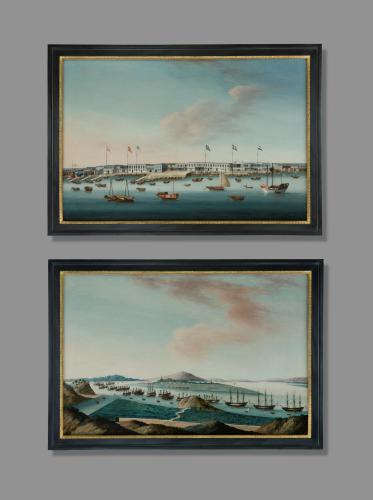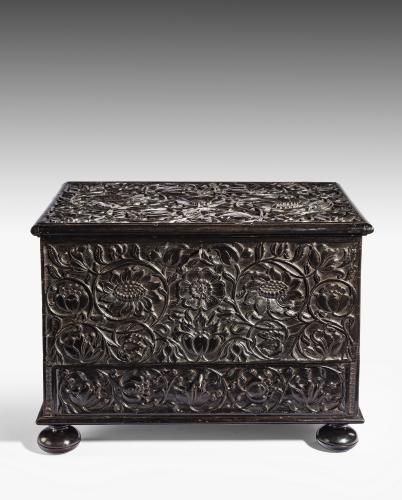
Price on application
This object includes complimentary, Insured Shipping / Delivery within the UK
This object is eligible for a Certificate of BADA Provenance
The BADA Standard
- Since 1918, BADA has been the leading association for the antiques and fine art trade
- Members are elected for their knowledge, integrity and quality of stock
- Our clients are protected by BADA’s code of conduct
- Our dealers’ membership is reviewed and renewed annually
- Bada.org is a non-profit site: clients deal directly with members and they pay no hidden fees
CHINA, CIRCA 1790.
Depicting a woman seated on an armchair, with a bedroom visible through a door in the background. In the original carved gilt wood Chinese frames.
After an original image. printed in England c.1780, probably as one of a series by the firm of Robert Sayer (1725–1794) and John Bennett (apprenticed by Sayer from 1765), publishers based near Fleet Street, London (see The Geffrye Museum of the Home / Mary Evans Picture Library). There are many different versions of this image by different publishers that survive. A version with the title ‘A Young Wanton’ sold at Christie's Paris, 20 December, 2006 (lot 786). A variation published by Carington Bowles (whose catalogue also featured many satirical subjects) is in the British Museum collection (2010,7081.2209). Many such images were satirical; women were often depicted in exaggerated fashionable dress and wigs, as vain or coquettish, the titles often providing a critique of the society of the day. The view through to the bedroom in this image and the direct gaze of the sitter, whose body is turned towards the bed, invites the viewer in and suggests ‘a man trap’. Another image on a similar theme by Carington Bowles carried that very title, (Wellcome Collection, 31733i).
According to the British Library, ‘Between 1770 and 1830 more than 20,000 satirical prints were published in London alone. The subject matter of these prints fell broadly into two categories: political subjects, such as commentary on the ruling elite, elections and wars with France on one hand; and modern tastes and fashions on the other. The variety of the prints was immense. Small black-and-white images could be purchased for a few pence, while hand-coloured images printed on textured paper were sold for two shillings each or more and collected as a series.’ (https://www.bl.uk/collection-items/spectators-at-a-print-shop-in-st-pauls-church-yard-london)
Further comparable images published by Sayer and Bennett in the same year include The Contemplative Charmer and The Toilet.
In ‘The Decorative Arts of the China Trade: Paintings, furnishings and exotic curiosities’, Carl L. Crossman comments that: ‘[b]y the 1780s the copying of English and European engravings had come into vogue, along with the painting of Chinese landscapes and genre subject matter’ (Antique Collectors’ Club, 1991, p.203). It was not unusual for almost identical mirror-image paintings to be produced, perhaps with a few details changed, to be sold as a pair, particularly where the subject was fashionable ‘beauties’, both European and Chinese.
Reverse glass painting in China: The delicate and meticulous process of producing a glass painting was undertaken by Chinese artisans who practiced the arts of painting and calligraphy. Whilst Chinese artists had been painting for centuries, the notion of painting on the reverse of a mirror was inspired by the Europeans. The technique of ‘reverse’ painting was already well-known in Europe and the design was traced on the back of the plate and then painted. Generally, the glass used for such pieces was imported from England, despite China’s long history of glassmaking. Contemporary reports note that the Chinese made glass for decorative objects but attempts at making flat glass were frequently ‘thin and brittle’ in contrast to the ‘thick and crystal-like’ glass produced in the West.
Dimensions
30 x 20 cmPrice on application
This object includes complimentary, Insured Shipping / Delivery within the UK
This object is eligible for a Certificate of BADA Provenance
Stock number
7061The BADA Standard
- Since 1918, BADA has been the leading association for the antiques and fine art trade
- Members are elected for their knowledge, integrity and quality of stock
- Our clients are protected by BADA’s code of conduct
- Our dealers’ membership is reviewed and renewed annually
- Bada.org is a non-profit site: clients deal directly with members and they pay no hidden fees



